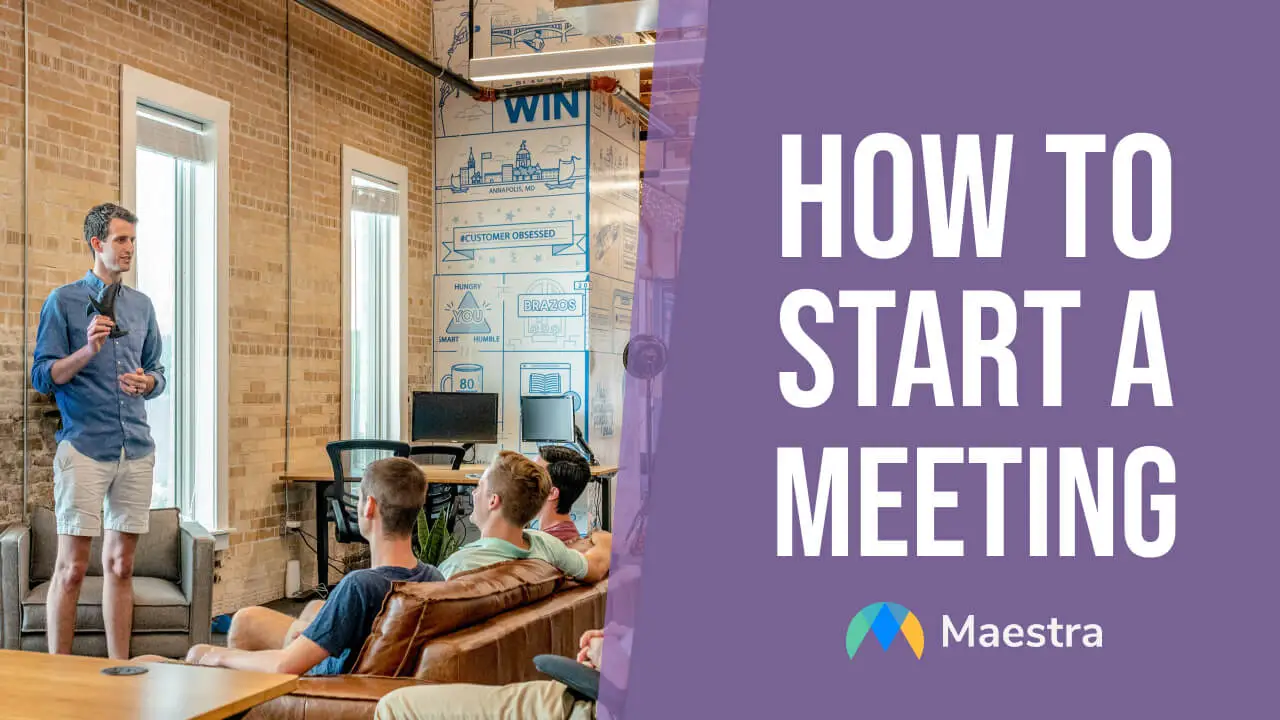How to Start a Meeting Effectively (with an Example Script)

In our busy workflows, much focus goes into what happens during meetings, and effective beginnings are often overlooked. Yet knowing how to start a meeting is just as important as problem-solving or decision-making processes.
In this blog, we will:
- Emphasize why successful meeting beginnings matter
- Guide you through how to start a meeting as a host (including the pre-planning phase)
- List common challenges and solutions you can face when starting a meeting
- Share a sample script for initiating a meeting
Let's get started.
Why does it matter to start a meeting well?
The way a meeting begins sets the tone for everything that follows. Here is why learning how to start a meeting matters:

How to Start a Meeting as a Host
Before we delve into the specifics on how to start a meeting, let’s first examine the fundamental elements that set the stage for a fruitful discussion. Consider the following as the four horsemen of meetings:
With these essentials in mind, it’s now time to prepare for the meeting, which will lay the foundation for a successful start.

Pre-Planning
Transcribe Your Meeting with AI
Initiating the Meeting
You’ve prepared well for your meeting, now is the time for some action. These are the core steps on how to start a meeting:
Optional: A check-in or icebreaker activity can foster connection among participants and ease the transition into the discussion. Depending on the meeting type, you can ask participants light questions related to the meeting theme or facilitate a brief round of introductions.
Common Challenges and Solutions for Starting Meetings
You may encounter certain challenges when learning how to start a meeting, and the following solutions can help you handle and overcome these issues with confidence.
| Challenge | Solution |
|---|---|
| Technical difficulties | Test all technology in advance and have a back up plan, such as alternative tools or communication methods. |
| Beginning later than planned | Apologize for the delay and immediately refocus the meeting on the objectives and agenda. |
| Late arrivals | Send reminders beforehand, and recap briefly for latecomers without disrupting the flow. |
| Lack of engagement | Use icebreakers or quick check-ins to get everyone involved early. |
| Nervous or hesitant participants | Create a welcoming atmosphere with a friendly tone and ask less formal questions to ease people into the discussion. |
| Side conversations or distractions | Politely remind participants if they stray off-topic, or use a "parking lot" for ideas. |

Starting a Meeting: An Example Script
[Welcome]
Welcome everyone! Thank you for being here today.
[Ground rules]
Before we begin, I’d like to go over a few ground rules. Please try to stay on topic, respect each other’s speaking time, and feel free to use the chat for any comments and questions during our discussion.
[Meeting purpose and roles]
Our main objectives for today’s meeting are to [e.g. review project updates, make decisions on next steps, etc.]. This will help us move forward efficiently and address any obstacles on our path. [Name] will facilitate the discussion, [name] will take notes, and [name] will keep track of time.
[Meeting agenda]
Here’s the agenda for today. We’ll start with [e.g. a project update from (name) about 15 minutes], followed by [e.g. a discussion on any challenges you’re encountering for 20 minutes]. We’ll wrap up with [e.g. a brainstorming session for our next steps, which will take 30 minutes].
[Questions]
Are there any questions you have about the agenda or objectives before we get started? Please share any thoughts or concerns.
[Transitions to first agenda item]
Let’s get started with our first agenda item: [e.g. the project update]. [Name], can you please take it from here?
Tip: You can share a visual version of the agenda (e.g. a slide presentation or a shared document) so everyone can follow along easily and refer to key points throughout the meeting.
Frequently Asked Questions
How to start a meeting with a client?
It’s essential to create a positive and productive atmosphere when starting a meeting with a client. First, greet the client warmly and introduce your team if they’re present. Share the meeting agenda to ensure it aligns with the client’s priorities, and a positive accomplishment or update to build momentum and enthusiasm.
How to start a meeting in a creative way?
To start a meeting in a creative way, you can organize a quick icebreaker activity, tell an inspiring anecdote, show a relevant video that can spark the discussion, or ask a trivia question related to the meeting’s topic. Remember that the best creative way depends on your team’s personality and the desired outcome of the meeting. Choose a method that will engage your team and help everyone feel involved.
How do you start a friendly meeting?
In a friendly meeting, you can start by sharing a light-hearted anecdote or express how nice it is to see familiar faces. Additionally, you can incorporate a team building exercise to strengthen bonds even further. It will also be nice to take a moment to acknowledge any personal milestones or achievements among the participants.
How do you make a good first meeting?
To make a good first meeting, research and learn about the client or organization you’re getting together with. Rehearse what you want to say, arrive on time or slightly early, and look for shared interests or experiences. Sending a thank you note after the meeting can keep communication lines open and help maintain the relationship.
What is the best opening statement for a meeting?
There is no single answer, as this depends on the context, participants, and purpose of the meeting. Still, if you’re wondering how to start a meeting with an impactful opening statement, remember that simple is better. Just include a warm welcome, a brief overview of the meeting objectives, and a positive note. Feel free to tailor your statement to resonate with participants.
Summary
This blog covered the fundamental rules and best practices on how to start a meeting. It also highlighted common challenges and solutions hosts can face when beginning a meeting, as well as an example script as a source of inspiration.
These are our 3 golden rules for initiating a meeting successfully:
- Communicate the meeting agenda and objectives clearly. Send them to the participants before the meeting so they can prepare in advance and know what to expect.
- Pay specific attention to your tone and body language. Remember, your demeanor can set the stage for the entire discussion.
- Keep calm and stay professional if something goes wrong. This will demonstrate leadership and reassure participants that the meeting can be still productive despite setbacks.
Now you’re ready to rock that meeting with a solid start and lead the process with confidence.


